When is Indian Republic Day?
On 26 January, India celebrates Republic Day.
This public holiday is one of four national Indian holidays and is always celebrated on this date.
History of Indian Republic Day
Republic Day is an important national holiday that commemorates the establishment of the Constitution of India. The adoption of the constitution marked the transition to full independence from Britain as it ended Lord Mountbatten's role as governor-general of India. 26 January was chosen as the date for the adoption of the constitution as it was on 26 January 1930 when the Declaration of Indian Independence was proclaimed by the Indian National Congress.
REPUBLIC DAY 2019
Republic day 2019 in India will be celebrated on 26th of January, at Saturday. In 2019, India will celebrate its 70thRepublic Day. First Republic Day of India was celebrated in 1950.
REPUBLIC DAY OF INDIA
Republic day in India is celebrated every year with great pride on 26th of January to honour the Constitution of India as it came into force on the same day in the year 1950. It had replaced the Government of India Act, 1935 into the governing document of India.
On this day, national holiday is declared by the Indian Government. The new Indian Constitution was sketched and approved by the Indian Constituent Assembly and decided to celebrate it on 26th of January every year as India became a republic country.
WHO IS THE CHIEF GUEST ON REPUBLIC DAY OF INDIA 2019
“Matamela Cyril Ramaphosa“, the fifth and current President of South Africa will be the Chief Guest on 70th Republic Day of India 2019.
Cyril Ramaphosa was invited by the Prime Minister, Narendra Modi during the G20 summit which was held in Buenos Aires, the capital of Argentina. He (from South Africa) was especially chosen for this occasion because India is celebrating the 150th birth anniversary of Mahatma Gandhi who had very close links with the people of South Africa. PM Modi said that the visit of the South African President to India will help in enhancing the ties between the two countries.
WHAT IS SPECIAL ON INDIAN REPUBLIC DAY 2019
We have given here some points on what are special activities this year on Indian Republic Day 2019:
- 2019 celebration will be special as this year will mark the 150th birth anniversary of ‘Father of the Nation’. The yearlong celebration will get started from Republic Day by paying tribute to Mahatma Gandhi.
- This year there will be around 17 tableaux from states/Union Territories and 6 from various ministries. The tableaux this year will be based on the theme ‘Gandhi’.
- The honorable delegates of Pravasi Bharatiya Divas 2019 (to be held in Varanasi from 21st to 23rd January 2019) will also be visiting Rajpath to witness the grandeurs of 70th Indian Republic Day celebrations.
- Prime Minister will inaugurate the ‘National War Memorial’ near India Gate on the eve of Republic Day to honour the soldiers who sacrificed their lives for the nation. IAF will carry out a special fly-past with three helicopters and SU 30 jets on the occasion.
- This year, Indian Air Force will be flying an aircraft which will run by blended bio-fuel on the Republic Day 2019 fly-past with 10 percent of bio-fuel in it. The aircraft will fly over Rajpath with a ‘V’ shape formation resembling ‘Victory’ sign.
- Rehearsals for the Republic Day parade 2019 have been started at Rajpath by all the contingents of Armed Forces and full dress rehearsal will be held on 23rd January. Around 600 children will also perform in the parade at Rajpath.
- Republic Day Parade 2019 will also witness the inclusion of M777 Howitzer and K9 Vajra, the self propelled gun which are the latest artilleries inducted in the Indian Army. T-90-Bhisma Tanks will also be seen in this year’s parade.
- This year one of the contingents of IAF will march on the tune of astronaut in the parade at Rajpath and the theme for the IAF tableau this year will be ‘Indian Air Force: Safeguarding Indian Skies’.
- It will be the first time that a woman officer would be leading the Army Services Corps in the 2019 Republic Day parade. The Daredevils Motorcycle Team will also include a women officer in their team this year.
- It will be the first time in history that all women contingent of Assam Rifles, which is one of the oldest paramilitary forces of India, will take part in the Republic Day parade this year.
- Republic Day 2019 Parade Tickets are available from 07th January to 25th January and from 27th January to 28th January for Beating Retreat ceremony at various locations and sales counters in Delhi.
REPUBLIC DAY 2019 PREPARATIONS/CELEBRATIONS IN THE STATES
- States have geared up for the full fledged preparations of Republic Day 2019 celebrations and the schools and colleges are in full swing to celebrate the day with enthusiasm and patriotism.
- Uttar Pradesh government would be releasing around 1500 prisoners who are aged or suffering from serious illness on the occasion of Republic Day 2019 from the jails of Agra, Bareilly, Fatehgarh, Naini and Varanasi.
- The 2019 Republic Day will also witness the stunt performances by 31 members ‘Dare Devils’ team of J & K Police on 41 motorcycles which will be held at University of Jammu on 26th January 2019.
- West Bengal will showcase its tableau based on ‘Gandhiji in Santiniketan and Beliaghata’ in this year’s Republic Day parade and Delhi tableau will depict the time Mahatma Gandhi’s spent in Delhi.
- Punjab will showcase its tableau at Rajpath about the history of Jallianwala Bagh. ‘Peace Within’ will be the theme of Arunachal Pradesh tableau showing Gandhi’s ideologies.
- This year in the Rajpath parade, Uttrakhand will be depicting the tableau of ‘Anasakti Ashram’, Kosani in Uttrakhand, where Mahatma Gandhi spent a considerable amount of time in 1929 and which he said as the ‘Switzerland of India’.
- Around 16 departments of Bihar government will showcase their tableaux in the state Republic Day celebration which will take place at Gandhi Maidan, Patna.
Who were Chief Guests on Republic Day of India 2018
The chief guests on Republic Day of India 2018 were 10 Leaders of 10 nations of the world (Heads of ASEAN states). Below is the list of names of all Chief Guests and their Nations:
- Sultan and incumbent Prime Minister Hassanal Bolkiah – Brunei
- Prime Minister Hun Sen – Cambodia
- President Joko Widodo – Indonesia
- Prime Minister Thongloun Sisoulith – Laos
- Prime Minister Najib Razak – Malaysia
- President Htin Kyaw – Myanmar
- President Rodrigo Roa Duterte – Philippines
- President Halimah Yacob – Singapore
- Prime Minister Prayuth Chan-ocha – Thailand
- Prime Minister Nguyễn Xuân Phúc – Vietnam
What was Special on 2018 Indian Republic Day
Following was special on 2018 Republic Day of India in New Delhi:
- India celebrated its Republic Day 2018 with the great leaders of 10 ASEAN (Association of South East Asian Nations) countries. The fly-past displayed the ASEAN flags in the sky on the occasion.
- It was the first time in Indian history that 10 chief guests graced the Republic Day of India. It was also special because ASEAN completed its 50 years of formation (created on 8 August 1967) and India completed its 25 years of partnership (started in 1992) with the grouping in 2017.
- ‘All India Radio’ made the debut in the Republic Day parade with a tableau on Prime Minister’s monthly address program ‘Mann Ki Baat’.
- 113 BSF women performed magnificent motorcycle stunts which were highly applauded by the audiences.
- The warfare capabilities showcased Aircraft Carrier Vikrant, Nirbhay Missile, Ashwini Radar System and Airborne Early Warning System (NETRA) in the parade.
- Around 61 tribal guests were invited to participate in the Republic Day celebration and 700 ASEAN students participated in the parade.
REPUBLIC DAY CELEBRATION
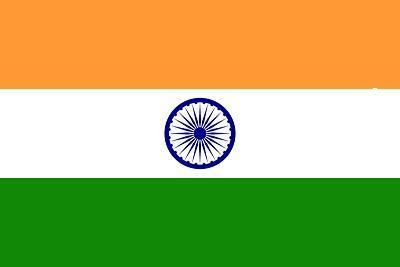
Like Independence Day is celebrated to enjoy the hard won freedom of India from the British Rule, Republic Day in India is celebrated to commemorate the coming of its own constitution into force. It is officially celebrated every year in the national capital of India (New Delhi) at Rajpath in the presence of the Indian President. Besides, celebrations in various other states also take place in the presence of their respective state governors by hoisting the National Flag of the country.
January 26 is declared as the national holiday all over the country by the Government of India. It is celebrated throughout the country with great enthusiasm and show by the students and teachers in schools, colleges, universities and other educational institutions.
An excellent parade and salute event is held by the military team at Rajpath in front of the India Gate in New Delhi, India.
HOW REPUBLIC DAY IS CELEBRATED
Events and celebrations are organized with great effort by the government of India in order to celebrate Republic Day in the Capital. A huge, grand military parade is held in New Delhi at Rajpath as well as the state capitals. Participants from the Indian Army, Air Force, Navy and traditional dance group takes part in the parade.
Parade held in New Delhi especially begins when prime minister of India pays tribute to the Amar Jawan Jyoti at India Gate. It is done to commemorate the sacrifices made by our Indian army soldiers while saving the country. Military salute is taken by the President of India during the parade in the Capital whereas military salute is taken by the state governors in their respective state capitals. On this special day, one foreign head of the state is invited as the president’s chief guest.
On this day, the soldiers of armed forces, common people and students from the school are honored with various national awards, such as Maha Veer Chakra, Ashok Chakra, Param Veer Chakra and Veer Chakra along with bravery medals for their exemplary work and performances. Most strikingly, the helicopters of our armed forces perform a show in the sky and shower rose petals over the audience sitting in India Gate. In addition, you can also enjoy various dance and singing performances by the school children. The staff of the armed forces performs rides through motorcycle whereas the staff from the Indian Air Force performs fly parade on the fighter planes (making tri color of the Indian Flag with the help of smoke) for offering the honor salute to our president.
A range of traditional and cultural programs are performed by the professionals from different states to focus on the history and culture of our country. During this grand celebration, prime minister’s rally and Lok Tarang – National Folk Dance Festival is also held from 24th to 29th of January.
All the government and non government offices of the nation and state, including post offices and banks remain closed on this day. Special security is organized on this day because of a huge gathering and to prevent any mishap from happening.
HISTORY OF CELEBRATING REPUBLIC DAY
India got freedom from the British Rule on 15th August 1947. At that time, there was no permanent constitution of the country. It was on 4th November 1947 that the first draft of the Indian Constitution was presented by the drafting committee to the national assembly. The first draft of the Indian Constitution was signed by the national assembly in both versions, i.e. English and Hindi on 24th January 1950.
Thereafter, the Constitution of India came into effect on Republic Day, i.e. 26th January 1950. Since then, 26th of January is being celebrated as the Republic Day in India. On this day, India was declared as the Purna Swaraj Country and thus we began celebrating this day as the anniversary of the Purna Swaraj Day.
The Constitution of India empowered the Indian Citizens to select their own government. The oath was taken by Dr. Rajendra Prasad as the first president of India at Durbar Hall in the Government House. India has a big history behind celebrating the Republic day.
IMPORTANCE OF CELEBRATING 26 JANUARY
Republic Day is the symbol of true spirit for the independent India where Indian President hoists our national flag and grand military parades, exhibiting the military equipment take place, including a variety of other events. Indian National Flag is tricolor in nature having horizontal stripes, i.e. upper saffron, middle white and bottom of dark green colour divided in equal proportions and a wheel (navy blue colour, having 24 spokes) in the centre representing the Sarnath Lion Capital of Ashoka.
India is a country where people from different cultures, societies, religions and languages live in harmony with each other. The freedom of our country is indeed a matter of great pride because needless to say it was obtained after many years of struggle and great sacrifice.
Therefore, this day is celebrated every year in order to make Indian people feel proud of having taken birth on this multi-cultural land. Republic Day is celebrated in a very colorful fashion in order to make celebrations memorable and special for every Indian Citizen. National Anthem is sung by the people who take part in the celebration. This celebration brings all the Indian people together and instills a feeling of national pride as well as love for our country.
Republic Day (26 January) Parade
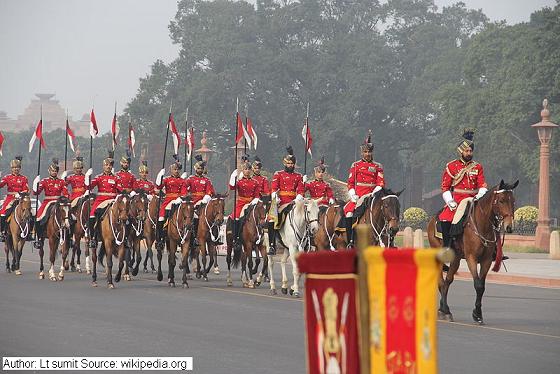
This is the actual picture from the Republic Day parade at Rajpath where the body guards of our president step out from the President’s house wearing the winter ceremonial dress. The bodyguards for the president are selected through a special selection procedure performed by the Indian Army from cavalry regiment, based in Rashtrapati Bhawan, New Delhi and the senior most unit of the Indian Army. The bodyguards of the Indian President are completely responsible for giving protection to the President of India. They remain fully armed with the equipment and BTR-60 vehicles in order to use them during the situation of crisis.

This is the picture of Republic Day parade where you can see an Agni-ll Ballistic missile on the display at Rajpath. Agni-II is a great Indian ballistic missile of an intermediate-range having a target capacity of around 3,500 km to 5,000 km deep. It has been developed as the most sophisticated Indian ballistic missile of its range having the circular error probably within 40 meters of range. After it, the Agni-lll Ballistic missile of India has also been developed as its successor in the month of June in 2011.
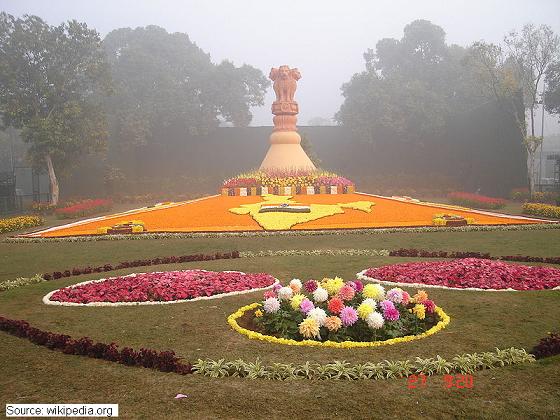
This is an exceptionally decorated picture of the Lion Capital at Rajpath on the occasion of the Republic Day of India. Right in front of the Lion Capital is made the map of India decorated with yellow flowers. In the middle of this map, an Indian Flag in tricolor is drawn out. Below the map of India, three circles are made within a big circle using flowers. Clearly, the Lion Capital wears such a mesmerizing look on this day!

This is yet another picture from the Republic Day parade by the exclusive BSF Camel Contingent of India at Rajpath. BSF of India is the Border Security Force of the Indian Government, under the administrative ministry control of Indian Home Affairs, which is responsible for guarding the Indian International Borders. BSF becomes one of the specially selected Central Armed Police Forces, which was established on 1st December 1965 to guard the International borders of India in order to maintain peace as well as to prevent trans border crimes. Indian BSF has the strength of around 240,000 personnel (both men and women) divided into 186 battalions. Indian BSF is the largest border guarding forces all over the world. The first Director General of the Indian BSF was K. F. Rustomji who had founded BSF in India and known as the “Founding Father of the Indian BSF”.

This is a remarkable shot from the Republic Day parade by the Indian Army Madras Regiment at Rajpath. The Madras Regiment of India is considered as the oldest regiment of the army formed in India during 1750s (Madras town was founded in the year 1639). It has become an old Indian regiment that experienced various campaigns of the British Indian Army and continuously as an Indian Army. Earlier during 1660s, it was developed as a Madras European Regiment by the East India Company; however later during 1750s, it was developed as a battalion by the Major Stringer Lawrence. After independence, the Madras Regiment was formed which has become involved in various campaigns like humanitarian aid operations and UN peacekeeping missions.
BEATING THE RETREAT CEREMONY – A MAGNIFICENT RITUAL BY THE INDIAN ARMY
The Beating the Retreat Ceremony is organized in Delhi, the capital city of India. As we know that the celebration of Republic day, i.e. 26th January, in Delhi kick starts with the multihued parade at Rajpath. But it’s not the parade that marks the end of this glorious day because the ceremony is brought to a closure with the ‘Beating the Retreat Ceremony’ that takes place on 29th of January. The venue for this ceremony is Vijay Chowk or the victory square, Delhi, having the majestic background of Rashtrapati Bhawan.
When Beating Retreat Ceremony is celebrated?
The Beating Retreat Ceremony is celebrated on 29th January in the capital city of Delhi. This ceremony is organized right after three days of the Republic Day celebration, i.e. on 26th January. The Beating Retreat Ceremony in Delhi officially marks the end of the Republic Day celebration.
Importance of Beating Retreat Ceremony
This festival of ‘Beating the Retreat Ceremony’ is observed every year in Delhi with a view to commemorate the age-old customs and tradition, which the soldiers brought to an end while approaching a war during the sunset. The sound of the bugles can be heard and its vibrations can be felt across the battleground and the fighting is called off.
This ceremony is marked as the official culmination point of the Republic Day celebrations. The whole view looks so majestic when the definite units of our military forces perform live executions. After their live performance, a hymn is being played by the group bands, which are collectively known as “Abide with me”. On this day, during the evening the bugles are played in order to produce retreat sound and the National Flag is brought down with the singing of National Anthem in an absolutely musical harmony. There are silhouetted riders who recede into the background and with this the celebration is brought to a close.
HIGHLIGHTS FROM RAJPATH, INDIA GATE, NEW DELHI – 2018
* (9:30 am) Prime Minister paid tribute to the Amar Javan Jyoti.

* (10:20 am) President, Ram Nath Kovind saluting the parade soldiers.
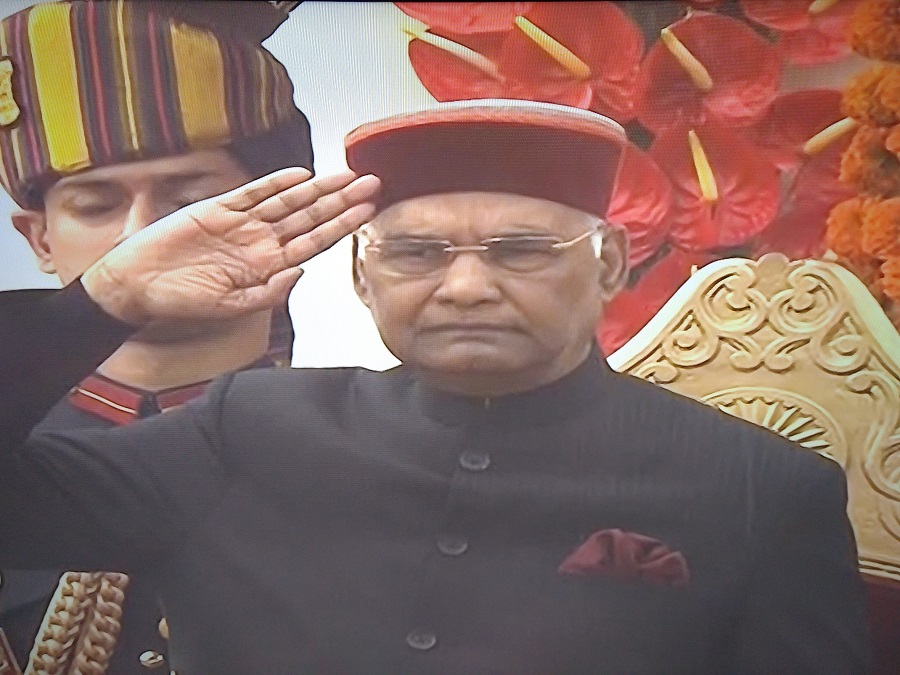
* Chief guests at Rajpath.
All the chief guests from ASEAN are sitting at Rajpath:

* Nirbhay Missile from The Defence Development and Research Organization at Rajpath.

* Indian Air Force tableau.
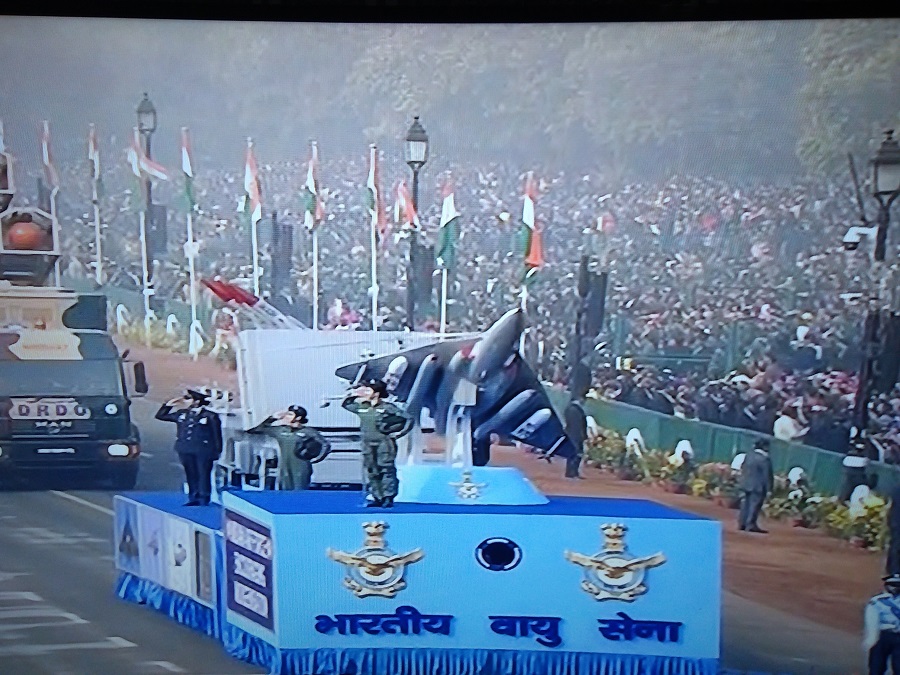
* ASEAN tableau showing 25 yrs of partnership of India with Southeast Asian bloc.
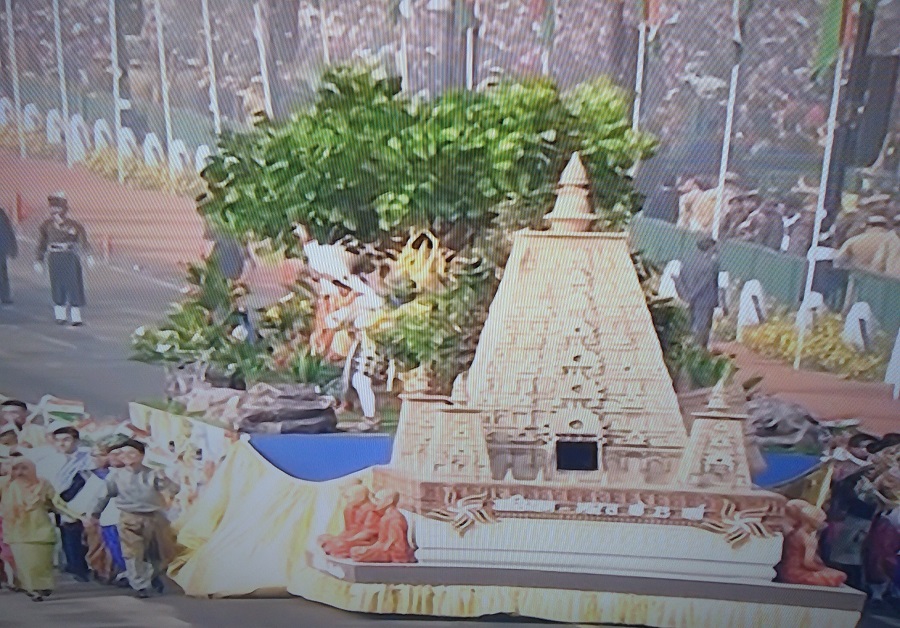
* A tableau from Panjab with the theme of “Sangat and Pangat”.

* A tableau from Income Tax Department with the theme Swachh Dhan Abhiyan.
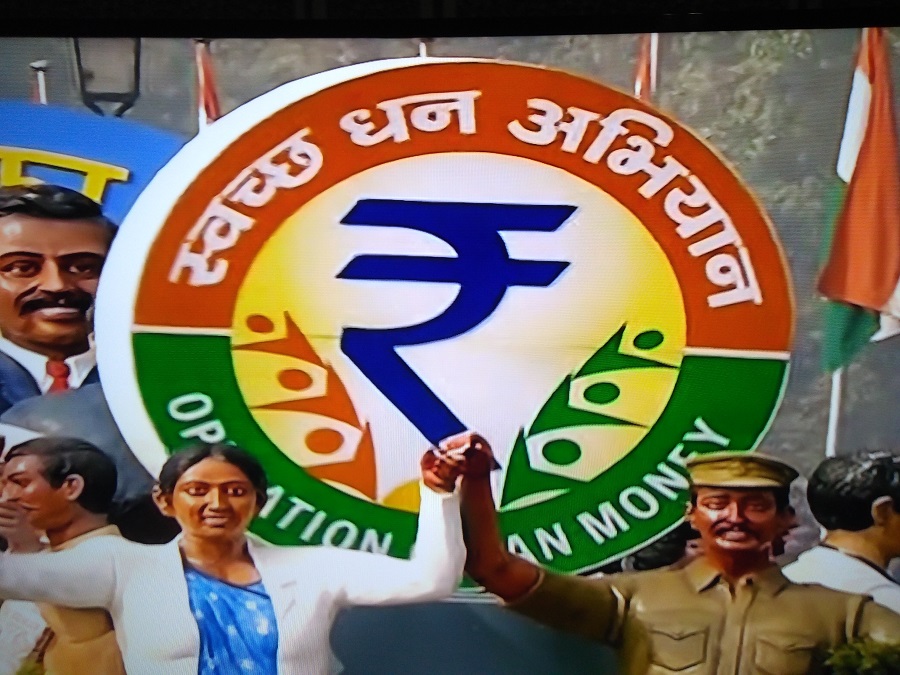
INDIAN REPUBLIC DAY CHIEF GUEST LIST FROM 1950 TO 2018
As every year, India follows the great Indian culture and tradition, i.e. “Atithi Devo Bhav” of welcoming the prime Minister or President of another country as a chief guest. This year, the chief guests on the Republic Day of India, 2018 were 10 great leaders from 10 countries of the world (Heads of ASEAN states). Below is the list of all chief guests welcomed in India at each Republic Day from the year India was declared as Republic country till 2018:
| Year | Guest Name | Country |
|---|---|---|
| 2019 | Cyril Ramaphosa | South Africa |
| 2018 | Sultan and incumbent Prime Minister, Hassanal Bolkiah Prime Minister, Hun Sen President, Joko Widodo Prime Minister, Thongloun Sisoulith Prime Minister, Najib Razak President, Htin Kyaw President, Rodrigo Roa Duterte President, Halimah Yacob Prime Minister, Prayuth Chan-ocha Prime Minister, Nguyễn Xuân Phúc | Brunei Cambodia Indonesia Laos Malaysia Myanmar Philippines Singapore Thailand Vietnam |
| 2017 | Crown Prince of Abu Dhabi Sheikh Mohamed bin Zayed Al Nahyan | Abu Dhabi |
| 2016 | President, Francois Hollande | France |
| 2015 | President, Barack Obama | USA |
| 2014 | Prime Minister, Shinzo Abe | Japan |
| 2013 | King, Jigme Khesar Namgyel Wangchuck | Bhutan |
| 2012 | Prime minister, Yingluck Shinawatra | Thailand |
| 2011 | President, Susilo Bambang Yudhoyono | Indonesia |
| 2010 | President, Lee Myung Bak | Republic of Korea |
| 2009 | President, Nursultan Nazarbayev | Kazakhstan |
| 2008 | President, Nicolas Sarkozy | France |
| 2007 | President, Vladimir Putin | Russia |
| 2006 | King, Abdullah bin Abdulaziz al-Saud | Saudi Arabia |
| 2005 | King, Jigme Singye Wangchuck | Bhutan |
| 2004 | President, Luiz Inacio Lula da Silva | Brazil |
| 2003 | President, Mohammed Khatami | Iran |
| 2002 | President, Cassam Uteem | Mauritius |
| 2001 | President, Abdelaziz Bouteflika | Algeria |
| 2000 | President, Olusegun Obasanjo | Nigeria |
| 1999 | King, Birendra Bir Bikram Shah Dev | Nepal |
| 1998 | President, Jacques Chirac | France |
| 1997 | Prime Minister, Basdeo Panday | Trinidad and Tobago |
| 1996 | President, Dr. Fernando Henrique Cardoso | Brazil |
| 1995 | President, Nelson Mandela | South Africa |
| 1994 | Prime Minister, Goh Chok Tong | Singapore |
| 1993 | Prime Minister, John Major | United Kingdom |
| 1992 | President, Mário Soares | Portugal |
| 1991 | President, Maumoon Abdul Gayoom | Maldives |
| 1990 | Prime Minister, Anerood Jugnauth | Mauritius |
| 1989 | General Secretary, Nguyen Van Linh | Vietnam |
| 1988 | President, Junius Jayewardene | Sri Lanka |
| 1987 | President, Alan Garcia | Peru |
| 1986 | Prime Minister, Andreas Papandreou | Greece |
| 1985 | President, Raúl Alfonsín | Argentina |
| 1984 | King, Jigme Singye Wangchuck | Bhutan |
| 1983 | President, Shehu Shagari | Nigeria |
| 1982 | King, Juan Carlos I | Spain |
| 1981 | President, Jose Lopez Portillo | Mexico |
| 1980 | President, Valéry Giscard d’Estaing | France |
| 1979 | Prime Minister, Malcolm Fraser | Australia |
| 1978 | President, Patrick Hillery | Ireland |
| 1977 | First Secretary, Edward Gierek | Poland |
| 1976 | Prime Minister, Jacques Chirac | France |
| 1975 | President, Kenneth Kaunda | Zambia |
| 1974 | President, Josip Broz Tito | Yugoslavia |
| Prime Minister, Sirimavo Ratwatte Dias Bandaranaike | Sri Lanka | |
| 1973 | President, Mobutu Sese Seko | Zaire |
| 1972 | Prime Minister, Seewoosagur Ramgoolam | Mauritius |
| 1971 | President, Julius Nyerere | Tanzania |
| 1970 | – | |
| 1969 | Prime Minister, Todor Zhivkov | Bulgaria |
| 1968 | Prime Minister, Alexei Kosygin | Soviet Union |
| President, Josip Broz Tito | Yugoslavia | |
| 1967 | – | |
| 1966 | – | |
| 1965 | Food and Agriculture Minister, Rana Abdul Hamid | Pakistan |
| 1964 | – | |
| 1963 | King, Norodom Sihanouk | Cambodia |
| 1962 | – | |
| 1961 | Queen, Elizabeth II | United Kingdom |
| 1960 | President, Kliment Voroshilov | Soviet Union |
| 1959 | – | |
| 1958 | Marshall Ye Jianying | People’s Republic of China |
| 1957 | – | |
| 1956 | – | |
| 1955 | Governor General, Malik Ghulam Muhammad | Pakistan |
| 1954 | King, Jigme Dorji Wangchuck | Bhutan |
| 1953 | – | |
| 1952 | – | |
| 1951 | – | |
| 1950 | President, Sukarno | Indonesia |


